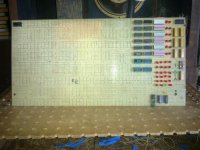Hi All;
PBirkel, Thank You for You suggestion.. "" But it might be a good point at which to take your "new circuit" and first verifying it by simulation before committing it to new-wires-and-sockets? ""
I have for a long time tried to stay away from Simulation, because of the steep Learning Curve of getting it into my head and the computer..
As well as all of the typing and debugging of that just to get it right, for the Schematic.. I could be all Wrong, but it seemed easier to just wire it, than all that would be needed to get it done by getting it into simulation..
I have looked at what everyone has offered earlier, and I would need to figure out, exactly how to enter it in IC mode instead of gate mode, which I never got past..
DDS, Thank You for the reply and the suggestion, Actually, I have been kind of doing this already..
As the Schematic is divided into sections, that are parts of the whole thing, and I have been checking each section..
But, I can in some cases further divide the sections into smaller parts..
And since they are machine wire wrap sockets, I could only put in the Ic's that are needed for a particular circuit..
I can and did put a circuit or two on my Breadboard and made what didn't work, work.. Trying different things, until I proved it would work as the origional circuit was, or what was needed to make it work..
Mostly, the 'fixes' are having to do with Ic counts, in other words on the Alu there are five signals that control what the Alu does, and in each of these there are anywhere from three to maybe eight gate delays on any of the control signals, and so they all don't reach the Alu at the same time..
Most of these are things like having a 7402 followed by a 7404, which I can instead replace with a 7432, and eliminate the 7404.. Or a 7400 followed by a 7404, which I can replace by a 7408 and eliminate the 7404..
And so by doing this I can bring them all closer to the three gates of delay..
Also, I can replace the 74175 which is a 6 register part, so two are required, with a 74174, which has 4 registers per part, so it will require three of these for the 12 bits.. But by doing this I can in a number of places eliminate 12 (7404) inversion gates and have less loading on the 74174, than was on the 74175..
THANK YOU Marty

